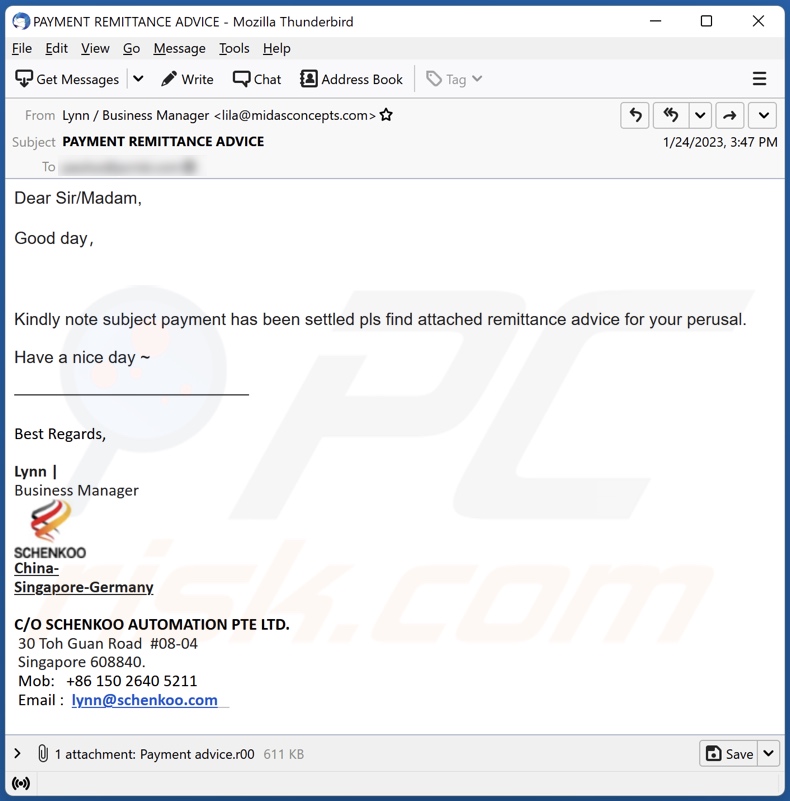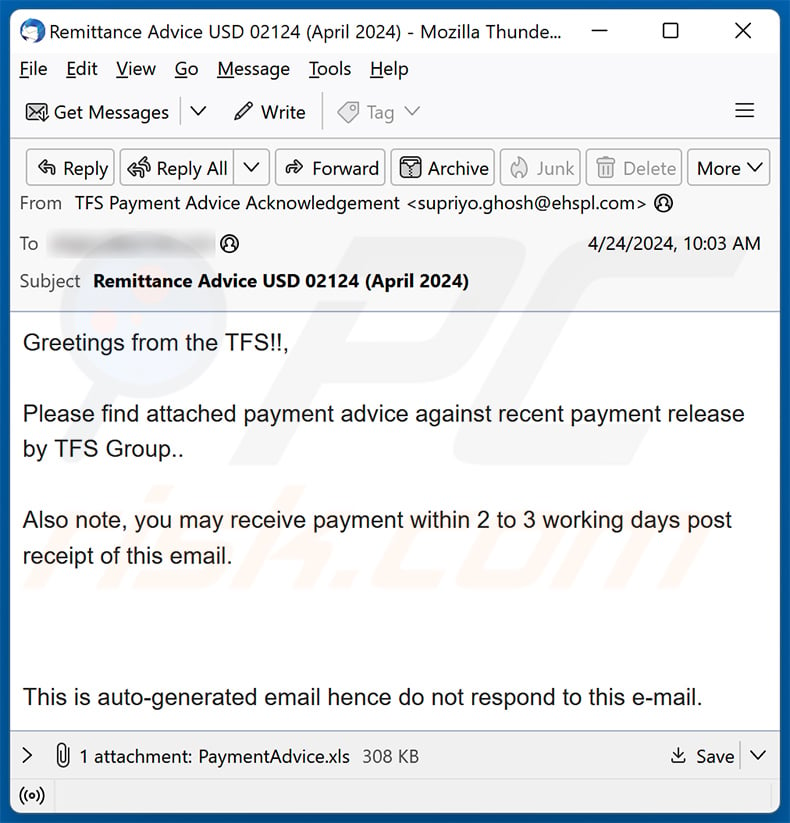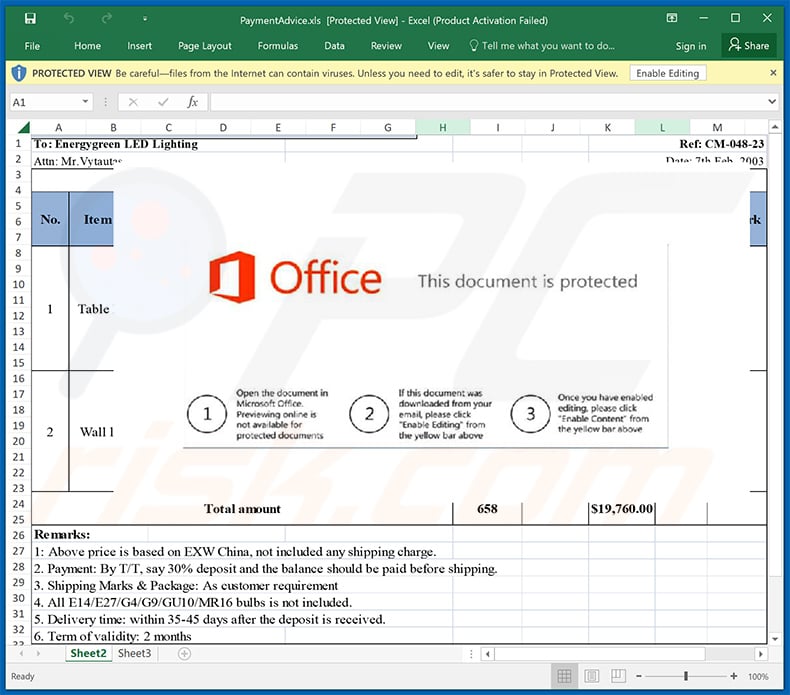Avoid infecting your device via fake "Payment Remittance Advice" emails
Phishing/ScamAlso Known As: "Payment Remittance Advice" malspam
Get free scan and check if your device is infected.
Remove it nowTo use full-featured product, you have to purchase a license for Combo Cleaner. Seven days free trial available. Combo Cleaner is owned and operated by RCS LT, the parent company of PCRisk.com.
What kind of email is "Payment Remittance Advice"?
Our inspection of the "Payment Remittance Advice" email revealed that it is spam. This letter is disguised as a message regarding a resolved payment, the details of which are supposedly in the attachment. However, the malicious file is designed to infect recipients' devices with malware.

"Payment Remittance Advice" email virus overview
The email with the subject "PAYMENT REMITTANCE ADVICE" (may vary) informs the recipient that a payment has been settled. The spam letter requests the user to review the "attached remittance advice". As mentioned previously, this email is fake, and any legitimate entities mentioned – are not associated with it.
The attached file is designed to infect machines with malware, potentially Formbook, XLoader, or a different malicious program.
To summarize, by trusting an email like "Payment Remittance Advice" – users can experience system infections, serious privacy issues, financial losses, and even identity theft.
If you believe that your device is infected – immediately perform a full system scan using an anti-virus and eliminate all detected threats.
| Name | "Payment Remittance Advice" malspam |
| Threat Type | Trojan, password-stealing virus, banking malware, spyware. |
| Fake Claim | Payment had been settled and the recipient is requested to view the attached remittance advice. |
| Attachment(s) | Payment advice.r00 (filename may vary) |
| Detection Names (attachment) | Avast (Win32:PWSX-gen [Trj]), Combo Cleaner (Gen:Trojan.Olock.1), ESET-NOD32 (Win32/Formbook.AK), Kaspersky (UDS:Trojan.MSIL.Injuke.gen), Microsoft (Trojan:Win32/Leonem), Full List Of Detections (VirusTotal) |
| Symptoms | Trojans are designed to stealthily infiltrate the victim's computer and remain silent, and thus no particular symptoms are clearly visible on an infected machine. |
| Distribution methods | Infected email attachments, malicious online advertisements, social engineering, software 'cracks'. |
| Damage | Stolen passwords and banking information, identity theft, the victim's computer added to a botnet. |
| Malware Removal (Windows) |
To eliminate possible malware infections, scan your computer with legitimate antivirus software. Our security researchers recommend using Combo Cleaner. Download Combo CleanerTo use full-featured product, you have to purchase a license for Combo Cleaner. 7 days free trial available. Combo Cleaner is owned and operated by RCS LT, the parent company of PCRisk.com. |
Malspam campaign examples
We have analyzed thousands of spam emails; "Statement Of Account (SOA)", "Pending Payment", and "Annual Leave" are just a few examples of malspam, while "Voice Note", "Jeff Bezos Charity Project", "Mercedes-Benz Lottery" – are a couple of our newest deceptive letter finds.
Spam mail is used to facilitate various scams and proliferate malware (e.g., trojans, ransomware, cryptominers, etc.). These letters can be variously disguised, even as messages from legitimate entities, e.g., corporations, companies, service providers, institutions, authorities, and others.
Due to how widespread spam mail is – we highly recommend exercising caution with incoming emails, PMs/DMs, SMSes, and other messages.
How do spam campaigns infect computers?
Spam emails can contain malicious files as attachments or download links. These files can be archives (ZIP, RAR, etc.), executables (.exe, .run, etc.), Microsoft Office and PDF documents, JavaScript, and so forth.
Once an infectious file is executed, run, or otherwise opened – the infection chain (i.e., malware download/installation) is triggered. For example, Microsoft Office documents infect devices by executing malicious macro commands.
How to avoid installation of malware?
We highly recommend being careful with incoming mail. The attachments and links found in suspicious emails and other messages – must not be opened, as they can be virulent. It is essential to use post-2010 Microsoft Office versions since they have the "Protected View" mode that prevents automatic macro execution.
However, it must be stressed that malware is spread using various techniques. Therefore, we also advise downloading only from official and verified channels. Additionally, software must be activated and updated using functions/tools provided by genuine developers, as illegal activation ("cracking") tools and fake updaters can contain malware.
Another recommendation is to approach browsing with caution since fraudulent and malicious content usually appears legitimate and harmless.
We must emphasize the importance of having a reputable anti-virus installed and kept up-to-date. This software must be used to run regular system scans and to eliminate detected threats and issues. If you've already opened malicious attachments, we recommend running a scan with Combo Cleaner Antivirus for Windows to automatically eliminate infiltrated malware.
Text presented in the "Payment Remittance Advice" spam email letter:
Subject: PAYMENT REMITTANCE ADVICE
Dear Sir/Madam,
Good day,
Kindly note subject payment has been settled pls find attached remittance advice for your perusal.
Have a nice day ~
Best Regards,
Lynn |
Business Manager
China-
Singapore-Germany
C/O SCHENKOO AUTOMATION PTE LTD.
30 Toh Guan Road #08-04
Singapore 608840.
Mob: +86 150 2640 5211
Email : lynn@schenkoo.com
Attachments:
Payment advice.r00 611 KB
Another example of an email from "Payment Remittance Advice" spam campaign:

Text presented within:
Subject: Remittance Advice USD 02124 (April 2024)
Greetings from the TFS!!,Please find attached payment advice against recent payment release by TFS Group..
Also note, you may receive payment within 2 to 3 working days post receipt of this email.
This is auto-generated email hence do not respond to this e-mail.
Screenshot of the attached malicious MS Excel document designed to inject malware into the system:

Instant automatic malware removal:
Manual threat removal might be a lengthy and complicated process that requires advanced IT skills. Combo Cleaner is a professional automatic malware removal tool that is recommended to get rid of malware. Download it by clicking the button below:
DOWNLOAD Combo CleanerBy downloading any software listed on this website you agree to our Privacy Policy and Terms of Use. To use full-featured product, you have to purchase a license for Combo Cleaner. 7 days free trial available. Combo Cleaner is owned and operated by RCS LT, the parent company of PCRisk.com.
Quick menu:
- What is "Payment Remittance Advice" malspam?
- Types of malicious emails.
- How to spot a malicious email?
- What to do if you fell for an email scam?
Types of malicious emails:
![]() Phishing Emails
Phishing Emails
Most commonly, cybercriminals use deceptive emails to trick Internet users into giving away their sensitive private information, for example, login information for various online services, email accounts, or online banking information.
Such attacks are called phishing. In a phishing attack, cybercriminals usually send an email message with some popular service logo (for example, Microsoft, DHL, Amazon, Netflix), create urgency (wrong shipping address, expired password, etc.), and place a link which they hope their potential victims will click on.
After clicking the link presented in such email message, victims are redirected to a fake website that looks identical or extremely similar to the original one. Victims are then asked to enter their password, credit card details, or some other information that gets stolen by cybercriminals.
![]() Emails with Malicious Attachments
Emails with Malicious Attachments
Another popular attack vector is email spam with malicious attachments that infect users' computers with malware. Malicious attachments usually carry trojans that are capable of stealing passwords, banking information, and other sensitive information.
In such attacks, cybercriminals' main goal is to trick their potential victims into opening an infected email attachment. To achieve this goal, email messages usually talk about recently received invoices, faxes, or voice messages.
If a potential victim falls for the lure and opens the attachment, their computers get infected, and cybercriminals can collect a lot of sensitive information.
While it's a more complicated method to steal personal information (spam filters and antivirus programs usually detect such attempts), if successful, cybercriminals can get a much wider array of data and can collect information for a long period of time.
![]() Sextortion Emails
Sextortion Emails
This is a type of phishing. In this case, users receive an email claiming that a cybercriminal could access the webcam of the potential victim and has a video recording of one's masturbation.
To get rid of the video, victims are asked to pay a ransom (usually using Bitcoin or another cryptocurrency). Nevertheless, all of these claims are false - users who receive such emails should ignore and delete them.
How to spot a malicious email?
While cyber criminals try to make their lure emails look trustworthy, here are some things that you should look for when trying to spot a phishing email:
- Check the sender's ("from") email address: Hover your mouse over the "from" address and check if it's legitimate. For example, if you received an email from Microsoft, be sure to check if the email address is @microsoft.com and not something suspicious like @m1crosoft.com, @microsfot.com, @account-security-noreply.com, etc.
- Check for generic greetings: If the greeting in the email is "Dear user", "Dear @youremail.com", "Dear valued customer", this should raise suspiciousness. Most commonly, companies call you by your name. Lack of this information could signal a phishing attempt.
- Check the links in the email: Hover your mouse over the link presented in the email, if the link that appears seems suspicious, don't click it. For example, if you received an email from Microsoft and the link in the email shows that it will go to firebasestorage.googleapis.com/v0... you shouldn't trust it. It's best not to click any links in the emails but to visit the company website that sent you the email in the first place.
- Don't blindly trust email attachments: Most commonly, legitimate companies will ask you to log in to their website and to view any documents there; if you received an email with an attachment, it's a good idea to scan it with an antivirus application. Infected email attachments are a common attack vector used by cybercriminals.
To minimise the risk of opening phishing and malicious emails we recommend using Combo Cleaner Antivirus for Windows.
Example of a spam email:

What to do if you fell for an email scam?
- If you clicked on a link in a phishing email and entered your password - be sure to change your password as soon as possible. Usually, cybercriminals collect stolen credentials and then sell them to other groups that use them for malicious purposes. If you change your password in a timely manner, there's a chance that criminals won't have enough time to do any damage.
- If you entered your credit card information - contact your bank as soon as possible and explain the situation. There's a good chance that you will need to cancel your compromised credit card and get a new one.
- If you see any signs of identity theft - you should immediately contact the Federal Trade Commission. This institution will collect information about your situation and create a personal recovery plan.
- If you opened a malicious attachment - your computer is probably infected, you should scan it with a reputable antivirus application. For this purpose, we recommend using Combo Cleaner Antivirus for Windows.
- Help other Internet users - report phishing emails to Anti-Phishing Working Group, FBI’s Internet Crime Complaint Center, National Fraud Information Center and U.S. Department of Justice.
Frequently Asked Questions (FAQ)
Why did I receive this email?
Spam emails are not personal. Cyber criminals distribute this mail in massive campaigns with the hopes that at least some recipients will fall for their scams.
I have provided my personal information when tricked by this spam email, what should I do?
If you have provided account credentials – change the passwords of all potentially exposed accounts and inform their official support without delay. And if you've disclosed other private data (e.g., ID card details, credit card numbers, etc.) – immediately contact the appropriate authorities.
I have read a spam email but didn't open the attachment, is my computer infected?
No, merely reading an email will not initiate any infection processes. Systems are compromised when a malicious attachment or link found in a spam email is opened/clicked.
I have downloaded and opened a file attached to a spam email, is my computer infected?
If the opened file was an executable (.exe, .run, etc.) – most likely, yes – your device was infected. However, document formats (.doc, .xls, .pdf, etc.) may need additional actions (e.g., enabling macro commands) to start downloading/installing malware.
Will Combo Cleaner remove malware infections present in email attachments?
Yes, Combo Cleaner is capable of detecting and eliminating most of the known malware infections. It must be stressed that since sophisticated malicious programs usually hide deep within systems – running a full system scan is essential.
Share:

Tomas Meskauskas
Expert security researcher, professional malware analyst
I am passionate about computer security and technology. I have an experience of over 10 years working in various companies related to computer technical issue solving and Internet security. I have been working as an author and editor for pcrisk.com since 2010. Follow me on Twitter and LinkedIn to stay informed about the latest online security threats.
PCrisk security portal is brought by a company RCS LT.
Joined forces of security researchers help educate computer users about the latest online security threats. More information about the company RCS LT.
Our malware removal guides are free. However, if you want to support us you can send us a donation.
DonatePCrisk security portal is brought by a company RCS LT.
Joined forces of security researchers help educate computer users about the latest online security threats. More information about the company RCS LT.
Our malware removal guides are free. However, if you want to support us you can send us a donation.
Donate
▼ Show Discussion